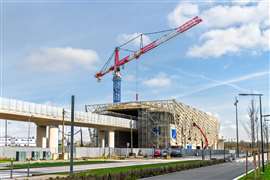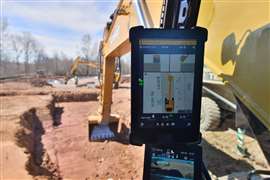Read this article in French German Italian Portuguese Spanish
Intermat: 3 takeaways as construction enters an uncertain new world
03 May 2024
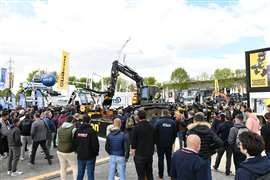 There were more than 127,000 visitors to Intermat 2024. (Photo: Intermat)
There were more than 127,000 visitors to Intermat 2024. (Photo: Intermat)
A team of journalists from KHL Group, which publishes Construction Briefing, was out in force at the Intermat show in Paris last month.
They tracked all the main launches, chewed the fat with exhibitors and visitors, and got their hands on the latest tech.
And after more than a few cups of coffee and hundreds of thousands of steps, International Construction editor Andy Brown and International Rental News managing editor Murray Pollok distil the experience down to three key takeaways:
1) Chinese OEMs accelerate global expansion plans
At Intermat there were 1,065 exhibitors – out of this total more than a quarter (290, to be exact) were Chinese. To put this into some context, there were 350 French based exhibitors for the Paris-based show and a mere 89 from Italy and just 59 from Germany.
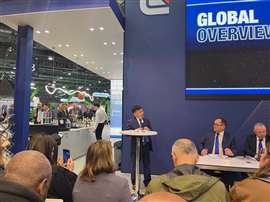 Chairman Zeng from LiuGong reveals the company’s plans for electric machines at Intermat.
Chairman Zeng from LiuGong reveals the company’s plans for electric machines at Intermat.
The fact that over a quarter of the exhibitors were from the other side of the world is a fitting illustration of the global ambitions of Chinese OEMs. The major OEMs that have, in recent years, come to dominate the top levels of the Yellow Table, KHL’s exclusive ranking of the world’s top 50 OEMs by sales, are all increasingly looking to markets outside of their home country.
For example, Zoomlion’s Mr. Fan Zhide, assistant general manager of Zoomlion Overseas Company told Construction Briefing at Intermat that the global revenue generated by Zoomlion Overseas is now 37% of the company’s total revenue overall; go back just five years and this figure would likely have been in single digits.
“This is because we restructure our strategy globally, in the last two and three years. Every year we realise very favourable increasing in the global market. So right now we are not just depending on the Chinese domestic market. For us, we are looking more for the global market. This is our strategy.”
The Chinese market has been one of dizzying highs and devastating lows. While the market is (slowly) beginning to recover, it makes sense that the major Chinese OEMs of XCMG, Sany, Zoomlion, LiuGong, and others would look to expand into other markets so they aren’t just reliant on one area. The initial focus was on developing regions like Africa and the Middle East but next in their sights are the construction powerhouses of Europe and North America – how well their strategy succeeds or not will influence the future of the industry. The presence of so many Chinese OEMs at Intermat was not by accident, but a reflection of their global ambitions.
2) Transition to new power tech will struggle without subsidies
Investing in expensive new power technologies, whether battery powered equipment – typically twice as expensive – or other technologies, is a big challenge facing contractors and rental companies.
It prompted a lot of discussion during Intermat about the availability, or lack, of financial incentives or subsidies from government to help accelerate the transition.
“We have to make choices, but it’s clear there has to be some incentives”, said Fabrice Blanc, equipment director at contractor Eiffage, speaking at one of the exhibition’s industry forums, “Why are there no subsidies? At some time they will have to help us. We are doing what we can, but to do so for all worksites, with no incentives, we can’t do.”
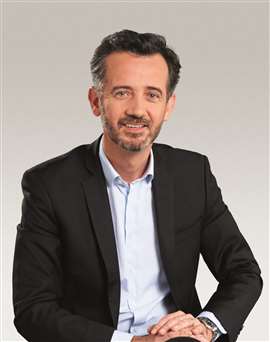 Olivier Colleau, CEO of Kiloutou Group. (Photo: Kiloutou)
Olivier Colleau, CEO of Kiloutou Group. (Photo: Kiloutou)
At the same forum, Olivier Grisez, managing director of Loxam’s French business, agreed; “If there is no clear incentive, we will be blocked by the cost. There has to be something – we need public subsidy. Going electric implies a significant cost.”
Olivier Colleau, CEO of Kiloutou, also at the forum, was clear about the challenges; “The price of electric machines is up to three times more expensive – batteries are more expensive. Today, the sector needs help to carry out this transition.”
This problem remains because, despite the investment being made in electric machinery, batteries for off-highway vehicles remain around twice the cost of those used in automotive applications, in part because of the additional protections and design work required and because the volumes are still lower.
And it is clear that rental companies are facing the brunt of the transition: their customers are asking for low carbon equipment. This also, of course, provides rental companies with a rare market opportunity to gain customers and at the same time increase rental penetration.
But it comes at a considerable cost. It is unlikely that talk of public subsidy will go away soon.
3) Moving on from ICEs proving a headache for OEMs
There is a sense – very evident at Intermat - that the construction industry has embarked on a journey knowing the destination - zero emissions - but with the means of travel not fully established.
One major manufacturer, a specialist in compact and light equipment, told Construction Briefing that it was currently examining four different scenarios involving hydrogen fuel cells and hydrogen combustion, and it was not yet clear which solution (or combinations) would work best. A work in progress…
Another compact specialist, Yanmar Construction Equipment, raised the issue of the industry requiring entirely new all-electric platforms for their machines – not simply installing a battery where an engine once stood. That implies OEMs running two distinct platforms until ICE engines are phased out. That will be an expensive business.
It also raised the prospect of some new business models, with Yanmar CE, for example, looking at selling all-electric platforms to other OEMs to use for their own electric machines.
At least in the sub-10 tonne sector it seems that battery electric is the way forward, although that still leaves the issue of charging infrastructure and working practices.
Some of the machines launched or previewed at Intermat will work for half a day on a full charge, which means that end users will have to factor in a different way of operating, even if they solve the on-site charging issue.
Speaking at the same conference session cited above, Fabrice Blanc, equipment director at Eiffage, made the point that organising charging facilities on major, long-term sites, is less of a problem than on multiple, small and mid-sized locations. More generally, he added, creating grid connections for sites for recharging is also a challenge.
Those in the construction equipment industry will remember very well the R&D effort and investment required to move to successive Stages or Tiers in engine emission regulations, with Tier 4 Final (in the US) and Stage V (Europe) being the ultimate challenge.
It is a measure of the scale of the energy transition that it is almost making these engine redesign efforts look relatively straightforward.
|
STAY CONNECTED



Receive the information you need when you need it through our world-leading magazines, newsletters and daily briefings.
CONNECT WITH THE TEAM







